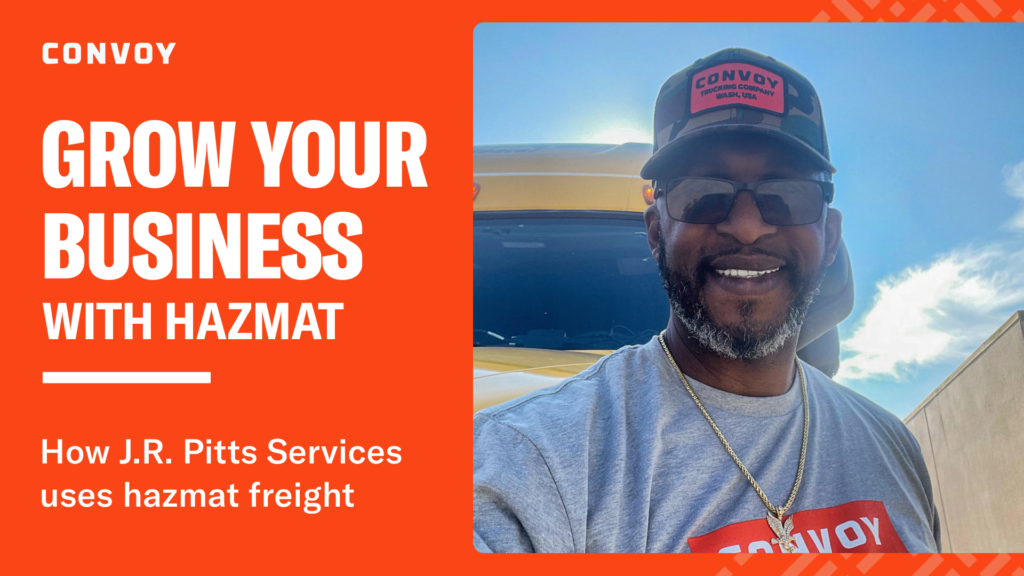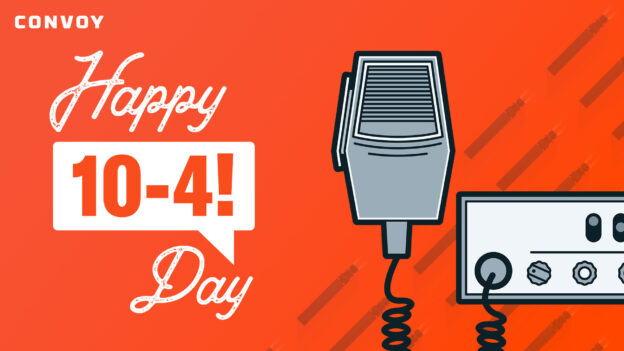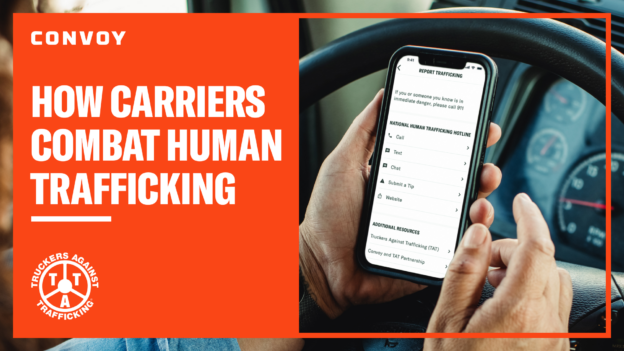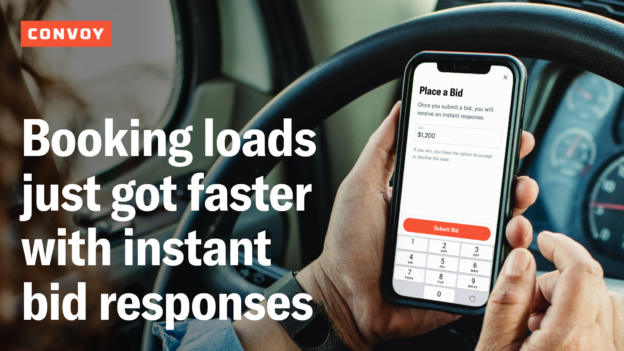Grow your business with hazmat
Carriers • Published on June 8, 2023
How J.R. Pitts Services uses hazmat freight and lessons from LTL to succeed in today’s trucking market
In a recent interview with James Pitts, J.R. Pitts Service’s founder, we learned how he transitioned from being a company driver to an owner-operator and built a successful trucking company from scratch. With a rigorous network strategy learned during his time as an LTL driver, James has grown his company from a single truck to eight trucks in just over two years. In this interview, he shares his insights on what has allowed J.R. Pitts Services to succeed in a challenging market, the importance of having a hazmat endorsement, and tips for fellow carriers and drivers.
| Interested in earning more money with hazmat loads? Learn how to get your hazmat endorsement below. |
How long have you been in trucking and how’d you get started with Convoy?
I’ve been trucking for about 23 years. I started as a company driver like everybody else and then, a few years ago, I got on with FedEx as an LTL driver. I thought I’d retire with them, but before the pandemic, they let a bunch of drivers go. I had some money and wanted to buy a truck, but didn’t think I’d have enough money to run it on my own. Through a friend, I got connected with a small company that was willing to let me put their numbers on my truck and teach me the business. That was great – I knew the driving part and I knew how to put loads together, so once they helped me learn the business side I was good to go. I ended up staying with them for about a year before going out on my own.
Once I got my authority, I tried Convoy and started running loads from Union City to Fort Pierce and back. A guy named Anthony from Convoy’s dedication team saw my pattern and asked if I wanted to run the lane on a dedicated contract. I only had one truck, but he took a chance on me, and we’ve been growing ever since.
What has allowed J.R. Pitts to succeed in today’s market?
I learned a lot about how to build a freight network when I was at FedEx running LTL and know what drivers around here want – they want to be home every night. Here in Valdosta at the state line between Georgia and Florida, I can have drivers pick stuff up in Atlanta, bring it down here and have another driver take it down to Florida and vice versa. We use this approach with my trucks and with my leased-on owner-operators. This strategy keeps our trucks moving and my turnovers low.
What else have you learned in your career that’s been useful in this market?
So much. First, my mindset has always been focused on consistent freight. I’m not the type of guy who runs to the loadboard to find the highest paying load. Sure, you might make a little less on a load, but in the end, you make more. When I was getting into this business an old fella told me, “James, a fast rolling dime will outrun a slow rolling quarter any day.” I put that thought together and realized that’s what Walmart does – volume and consistency – and that’s what I try to do with my business. Second, the more certifications or endorsements you have, the better. For example, LTL carriers will require all their drivers to have a hazmat endorsement because companies are willing to pay a lot of money to get a couple of pallets across the country if it’s hazmat. So, I saw the importance of hazmat and now I’m making all my drivers get their endorsement to ensure that we can pull those higher-priced loads when they come through.
What’s the process for getting a hazmat endorsement?
It’s pretty easy. You need to get some training, pass a test with your state, clear a federal background check, and update your insurance to cover Hazmat. It doesn’t cost much to do and frankly, I’m surprised more carriers don’t do it.
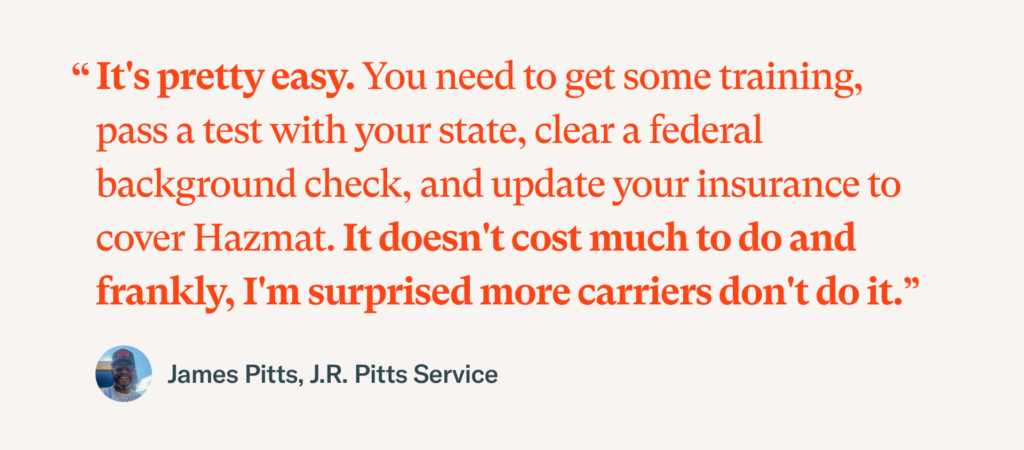
I suppose some people are worried about the training part. In my case, I’ve got some friends that used to train at larger carriers, so they can get my guys going. Some of the training options are online, but having someone there in person who can explain things like what a placard is, where it goes, and how to use it is a big help.
How much extra should carriers expect to pay for insurance?
It depends, but it’s not that much more. I think my insurance is about 25% more than friends who don’t haul hazmat. We haul enough hazmat that the extra cost is worth it since we make more money on those loads. However, you have to be careful to make sure you’re offsetting the extra cost. If you’re dispatching leased drivers on your authority, you also need to make sure they have all the necessary hazmat insurance and endorsements. Keep in mind that with hazmat, it’s not just about the extra money you get on a load. With hazmat, I can do more for a broker, and that opens up more opportunities.
Do you have tips you’d share with your fellow carriers and drivers?
Absolutely. Carriers need to understand that the market goes up and it goes down. When it goes up, I capitalize on the rates and save your money. I don’t spend it on cars or whatever. Then, when it goes down like it always does, you don’t have to worry as much because you have money to keep the business running. I just had a truck breakdown the other day, my favorite truck. The engine locked up when I was coming home from Locust Grove. Between towing and repairs, it’s going to cost me maybe $20,000, but I’ve got money in a maintenance account, so I’m not worried about it.
Also, you need to have a strategy. In today’s market, I keep telling guys to quit looking for that one big score. They might find a $5,000 load out to Arizona, but they’re going to spend $2,000 in fuel and they’ve got no plan to get back home. For me, I look for consistent freight on lanes I know, usually with dedicated contracts. Profit is profit, and I know how to make this strategy work.
Finally, for the new guys, find someone who will teach you the business. Learn from them before you go out on your own.
Ready to get your hazmat endorsement?
|
New carrier to Convoy?
Already hauling with Convoy?
